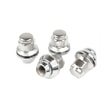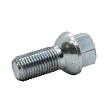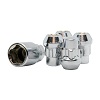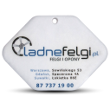How to choose tires for rims?
Are you buying new tires? Want to choose wider tires for your rims? Not sure which tires will fit your rims? Learn the basics of selecting tires for rims.
Every driver needs to buy a new set of tires from time to time. Sometimes these might be winter tires or a lowered profile model. So how can you check if they'll fit your existing rims? It's easy. Simply learn the basic rules for matching rims and tires to see what fits. So, here are some important tips that will help you avoid mistakes and assemble a reliable rim-and-tire set that works for your car.
Choosing a tire for your rim is a very important matter and you should approach it with the right knowledge, without which you can make the wrong choice, resulting in serious consequences for your car and your safety.
Does every tire fit the rim?
It's important to remember that the rim and tire form a unit, and for them to work well together, they must be properly matched. The tire should be designed for a specific rim diameter, as indicated in inches. There's a certain amount of leeway when it comes to width adjustments. However, the best solution is to use tires recommended by the vehicle manufacturer.
If you're replacing both tires and rims on your car, remember that you can't change the overall diameter of the wheels by more than 2 percent less or more than 1.5 percent more. Cars are designed within these limits, and exceeding them can cause numerous problems.

What should you consider when choosing tires for rims?
When choosing tires for rims, you should primarily consider whether they are designed to work with that specific rim size. The next step is to match the tire width to the rim. Suitable widths are listed in the table in the next section. In many cases, it's possible to exceed the specified range, but this is not recommended for the many reasons listed below.
Be sure to choose tires from reputable manufacturers. They guarantee proper performance for a long time. These can be excellent Goodyear tires , for example.
Don't forget about other equally important tire parameters. Low load or speed ratings can be very dangerous. If the tires are too weak for your car, not only will they wear out faster, but they can also unexpectedly fail while driving. Such a failure can lead to a very serious accident, potentially affecting you, your loved ones, and even other people. Safety is paramount and shouldn't be compromised for financial or other reasons.
How to choose the right tire size for your rim?
Each tire is clearly marked with its specific parameters. These include numbers and letters indicating specific dimensions. An example tire marking is:
215/55 R16 91V
Where:
- 215 – tire width in millimeters;
- 55 – profile – side wall height as a percentage of the width;
- R – radial construction, in agricultural machines also D – diagonal;
- 16 – diameter of the rim the tire fits;
- 91 – load capacity index;
- V – speed index.
You can find this information in many places in your car's owner's manual, on the driver's door pillar, in the glove compartment, and on the fuel filler flap. Of course, this applies to cars with original rims; if someone has already replaced them, you should check the markings on the rim.
How to choose tires for rims in Poland? Just like anywhere else, use the appropriate size charts. These can be Kormoran tires from a Polish manufacturer, for example. When choosing a tire for rims, the most important factor is the diameter of the rim it fits, as indicated on the tire. Below is a table listing the tire widths that fit specific rims. Tire to rim selection calculator:
| Tire size [mm] | Rim width range [inches] | Recommended rim width [inches] |
| 125 mm | 3.0 - 4.0 inches | 3.5 inches |
| 135 mm | 3.5 - 4.5 inches | 4.0 inches |
| 145 mm | 4.0 - 5.0 inches | 4.5 inches |
| 155 mm | 4.0 - 5.0 inches | 4.5 inches |
| 165 mm | 4.0 - 5.5 inches | 5.0 inches |
| 175 mm | 4.5 - 6.0 inches | 5.0 inches |
| 185 mm | 5.0 - 6.5 inches | 5.5 inches |
| 195 mm | 5.5 - 7.0 inches | 6.0 inches |
| 205 mm | 5.5 - 7.5 inches | 6.5 inches |
| 215 mm | 6.0 - 8.0 inches | 7.0 inches |
| 225 mm | 6.0 - 8.5 inches | 7.5 inches |
| 235 mm | 7.0 - 9.0 inches | 8.0 inches |
| 245 mm | 8.5 - 10.0 inches | 9.0 inches |
| 255 mm | 8.5 - 10.0 inches | 9.0 inches |
| 265 mm | 9.0 - 10.5 inches | 9.5 inches |
| 275 mm | 9.0 - 11.0 inches | 10.0 inches |
| 285 mm | 9.5 - 11.5 inches | 10.5 inches |
| 295 mm | 10.0 - 11.0 inches | 10.5 inches |
By checking the table you will be sure that you have selected the correct tire size for the rim.

Incorrectly selected tires - consequences
Poorly selected tires can have a number of very unpleasant consequences, the most common of which is premature tire wear. And this is the least serious consequence of a poorly matched tire to the rim. The risks posed by a poorly selected tire include:
- accelerated tire wear;
- deterioration of the ABS and ESP systems;
- reduced adhesion;
- less driving comfort.
That's why, to avoid such negative consequences, choosing the right tire for the right rim is so important. A poor choice alters what has been tested by the engineers of the company producing the car model and can lead to precisely these consequences.
A tire that's too wide for the rim is a common mistake, but it's also a deliberate action by some people. Wider tires offer many advantages, such as better handling, better traction, and shorter braking distances. Unfortunately, there are also disadvantages, such as higher fuel consumption, increased noise, and possible problems in large ruts. So, if you stay within the tolerance range (given in the table above), you can install wider tires; if not, you should replace the rims along with the tires. However, if you've fitted a tire that's too wide for the rim, it can significantly reduce (for example) water drainage through the grooves on the tire's sides. This exposes you to the very dangerous phenomenon of aquaplaning, or "driving into water" and complete loss of vehicle control.
Some tuned cars have so-called stretch tires. This involves using a tire that's significantly narrower than the rim. This is simply for what some consider an attractive look. Driving on such tires, however, is dangerous, as they can come off the rim and lead to a dangerous situation.
Driving comfort on such tires is also significantly reduced. The tire loses its semi-circular shape, leading to uneven tread wear and a much quicker need for replacement. The tire width should be carefully matched to the rim, as close as possible to the recommended width.
If you're looking for tires for your car, check out the renowned Bridgestone tires . If you also want to replace your rims or buy a second set to alternate with winter tires, also choose the right aluminum rims for your car. A second set of tires with rims is a common solution. Storing a complete wheel doesn't take up any more space, and changing wheels is faster than changing entire tires. Frequent or improper removal of the tire from the rim can damage both these components.
Also remember that, according to Polish law, the rim cannot protrude beyond the car's outline. Such modifications can result in a hefty fine and the loss of your vehicle registration. Every car manufacturer also specifies the wheel arch depth, which directly determines the maximum wheel size that will fit through the arch when turning. Rubbing the tire against the wheel arch in any position will lead to rapid tire damage.

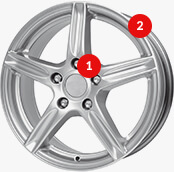

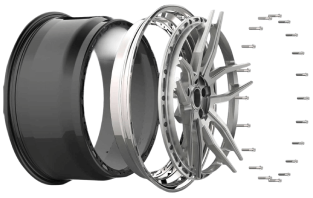
 Modern design
Modern design Perfect fit
Perfect fit High durability
High durability Free shipping within 24 hours
Free shipping within 24 hours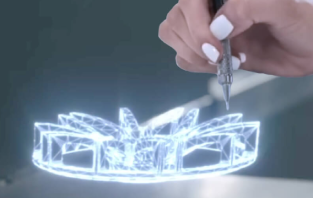
 Individual project
Individual project Dedicated caregiver
Dedicated caregiver
